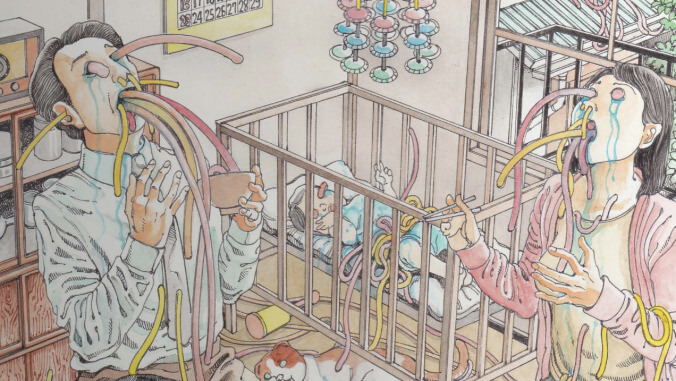The cascading fears of Razorblades: The Horror Magazine are scary good
A new anthology featuring a who’s who of great comic artists reveals the different faces of horror

Born in 2020 amidst isolation and death—and, yes, a brief pause in the American comics market due to the pandemic—Razorblades: The Horror Magazine was a successful experiment in creator-owned publishing. The inaugural iteration of the magazine itself has ended, but the creators intend to continue with the larger project. And in its five issues, the publication has featured the work of a laundry list of notable names: James Tynion IV and Steve Foxe (who co-created Razorblades as well as publishing and editing it, respectively), Daniel Kraus, Jenna Cha, Aditya Bidikar, Scott Snyder, Nadia Shammas, Hannah Comstock, Shintaro Kago, and many other great creators have already contributed to this new endeavor.
Though the magazine features prose, comics, and illustration, most of the creators have some background in comics. (Both co-creators mention their shared love of Taboo, the anthology comic in which Alan Moore and Eddie Campbell’s From Hell was originally serialized.) The range and format of stories available within the magazine is as wide as it is likely due to the creators’ stated concern over the dearth of horror magazines in the American landscape. The inclusion of prose connects Razorblades to the pulp magazines that originated in the late 19th century and popularized many figures that would become horror staples, vampires chief among them.
Furthermore, the anthology format—as is discussed in a missive in the fourth issue—is especially fitting for horror, as it allows for wildly different approaches to the core theme of conveying the unknown. If a reader is not scared by the subject matter or style of one story, another might be perfectly attuned to their nerves. Additionally, the overall effect of having various fears explored in conversation with one another creates a feeling of cascading dreads, that feed off each other, in the reader.
As Razorblades is primarily a comics magazine, the format has affected the sequentiality of the individual comics themselves, but also that of the larger book. There are, of course, the serials, whose long-form sequentiality is nested between—and thus juxtaposes—the self-contained but viscerally lingering scares of the shorts. Parallel to this, prose horror microfiction stories generate tightly packed narratives of the macabre in between the accompanying images, with the occasional longer prose stories appearing as well.
In fact, one comic touches on this effective juxtaposition in its form. Vita Ayala, Kelly Williams, and Hassan Otsmane-Elhaou’s “Origin of Man” shifts from the linear sequentiality of prose straight into comics. On the margins of one page are the faces of characters described in the lettered prose of the comic; on the next, caption boxes continue the narration of the prose. These are stamped over the panels that further the story from there on—the caption boxes have the appearance of ripped prose pages, a flourish common in Otsmane-Elhaou’s lettering, especially in numerous other comics within Razorblades on which he worked.
This isn’t to imply that the lettering across Razorblades’ five issues is static. Otsmane-Elahou tailors it to each comic. Consider it another benefit of the anthology’s variation: One can trace how a single letterer’s style adapts to different horror narratives, thus revealing a little, perhaps, about the texture of horror’s various subgenres.
